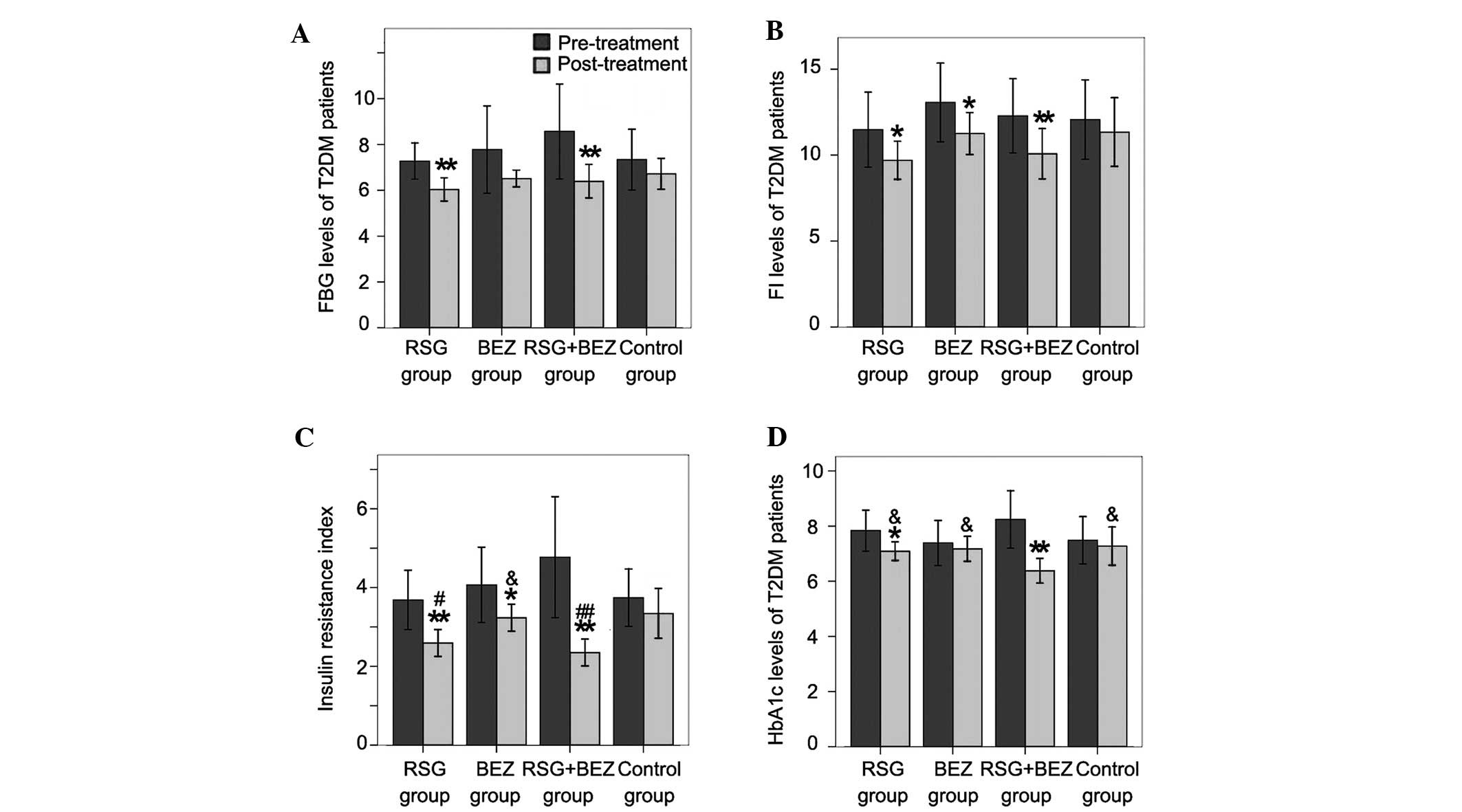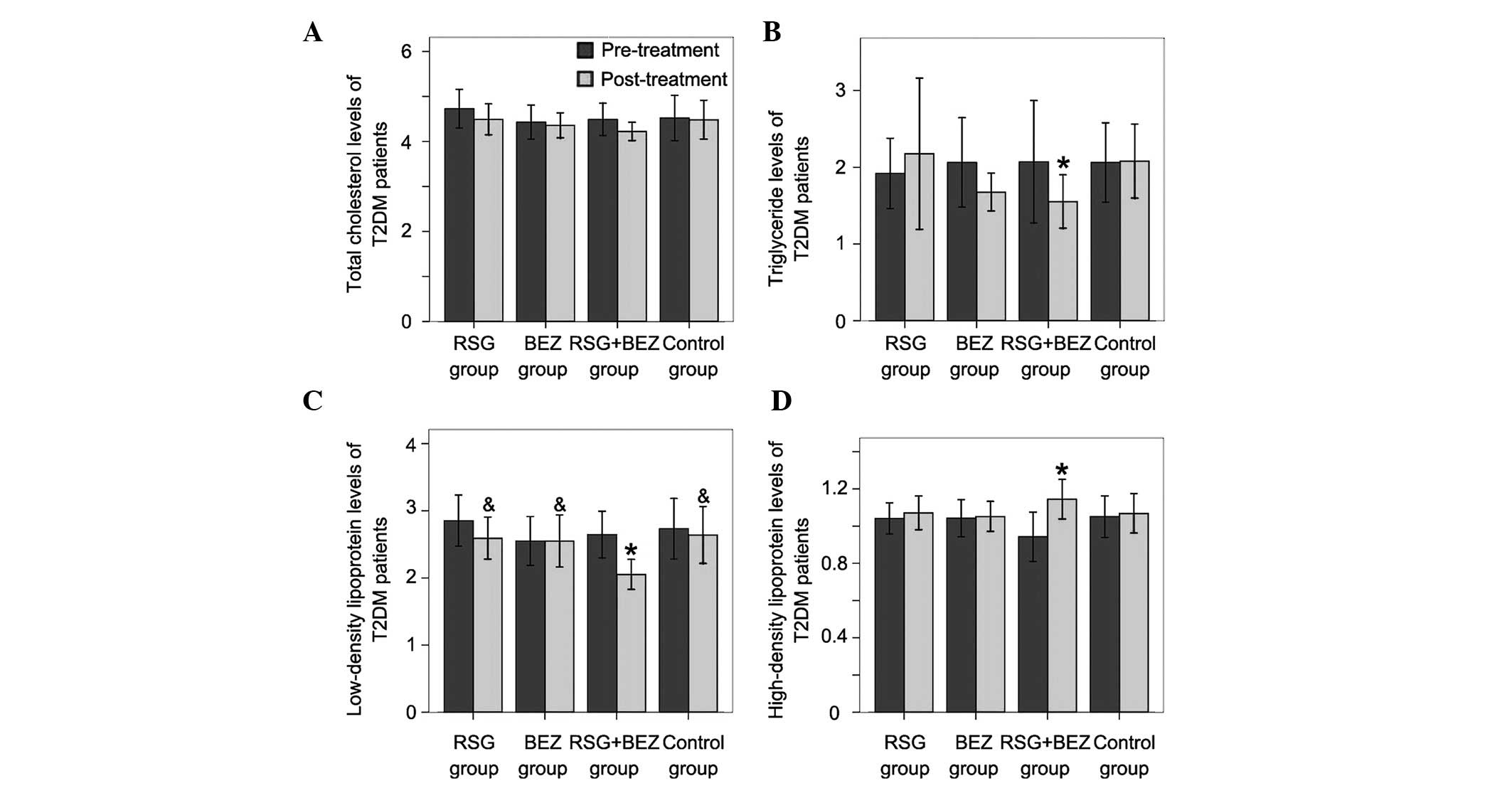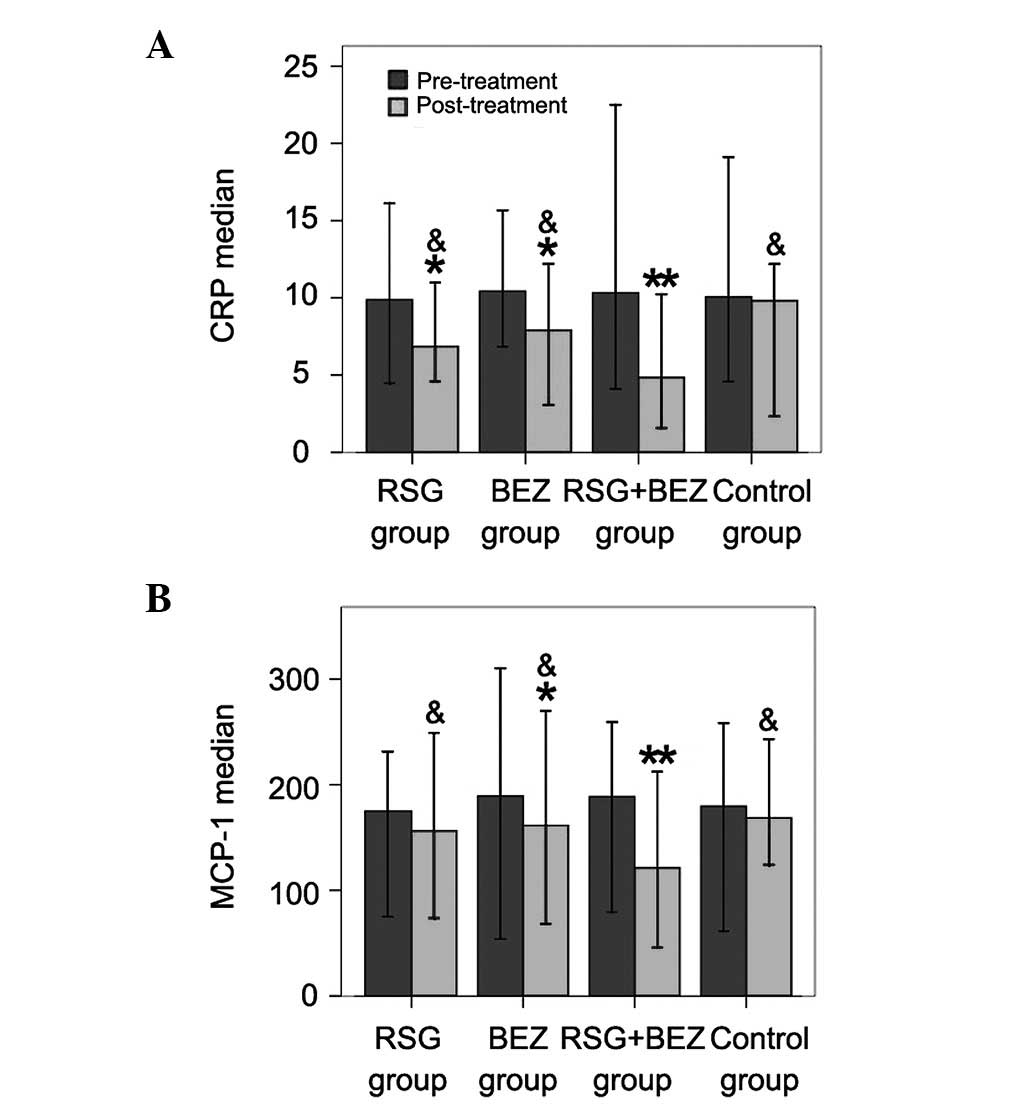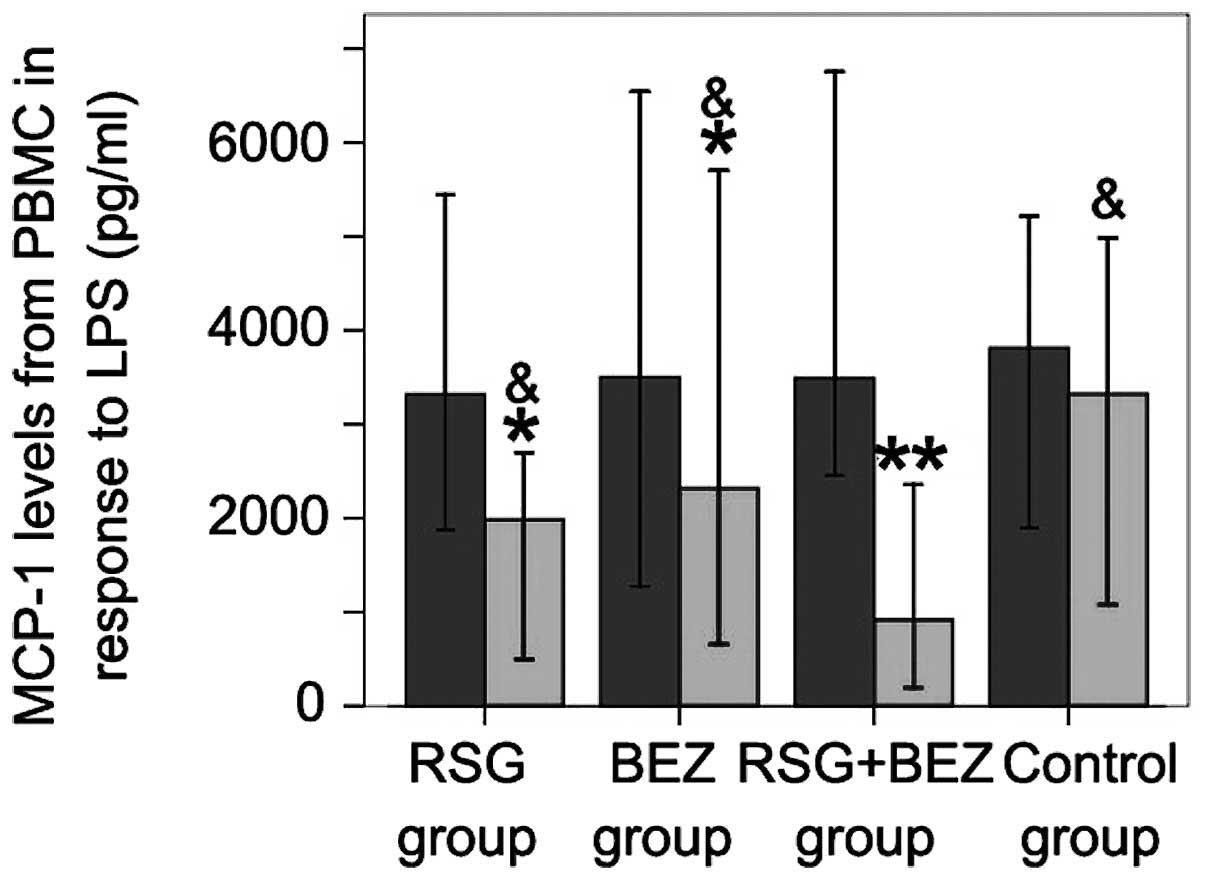|
1.
|
Haffner SM, Lehto S, Rönnemaa T, Pyörälä K
and Laakso M: Mortality from coronary heart disease in subjects
with type 2 diabetes and in nondiabetic subjects with and without
prior myocardial infarction. N Engl J Med. 339:229–234. 1998.
View Article : Google Scholar : PubMed/NCBI
|
|
2.
|
Shirani J and Dilsizian V: Screening
asymptomatic patients with type 2 diabetes mellitus for coronary
artery disease: does it improve patient outcome? Curr Cardiol Rep.
12:140–146. 2010. View Article : Google Scholar
|
|
3.
|
Desvergne B and Wahli W: Peroxisome
proliferator-activated receptors: nuclear control of metabolism.
Endocr Rev. 20:649–688. 1999.PubMed/NCBI
|
|
4.
|
Becker J, Delayre-Orthez C, Frossard N and
Pons F: Regulation of inflammation by PPARs: a future approach to
treat lung inflammatory diseases? Fundam Clin Pharmacol.
20:429–447. 2006. View Article : Google Scholar : PubMed/NCBI
|
|
5.
|
Calkin AC and Thomas MC: PPAR agonists and
cardiovascular disease in diabetes. PPAR Res. 2008:2454102008.
View Article : Google Scholar : PubMed/NCBI
|
|
6.
|
Inoue I, Goto S, Mizotani K, et al:
Lipophilic HMG-CoA reductase inhibitor has an anti-inflammatory
effect: reduction of mRNA levels for interleukin-1beta,
interleukin-6, cyclooxygenase-2, and p22phox by regulation of
peroxisome proliferator-activated receptor alpha (PPARalpha) in
primary endothelial cells. Life Sci. 67:863–876. 2000.
|
|
7.
|
Staels B, Koenig W, Habib A, et al:
Activation of human aortic smooth-muscle cells is inhibited by
PPARalpha but not by PPARgamma activators. Nature. 393:790–793.
1998. View Article : Google Scholar : PubMed/NCBI
|
|
8.
|
Turay J, Grniaková V and Valka J: Changes
in paraoxonase and apolipoprotein A-I, B, C-III and E in subjects
with combined familiar hyperlipoproteinemia treated with
ciprofibrate. Drugs Exp Clin Res. 26:83–88. 2000.PubMed/NCBI
|
|
9.
|
Marx N, Sukhova G, Murphy C, Libby P and
Plutzky J: Macrophages in human atheroma contain PPARgamma:
differentiation-dependent peroxisomal proliferator-activated
receptor gamma (PPARgamma) expression and reduction of MMP-9
activity through PPARgamma activation in mononuclear phagocytes in
vitro. Am J Pathol. 153:17–23. 1998.
|
|
10.
|
Jiang C, Ting AT and Seed B: PPAR-gamma
agonists inhibit production of monocyte inflammatory cytokines.
Nature. 391:82–86. 1998. View
Article : Google Scholar : PubMed/NCBI
|
|
11.
|
Delerive P, De Bosscher K, Besnard S, et
al: Peroxisome proliferator-activated receptor alpha negatively
regulates the vascular inflammatory gene response by negative
cross-talk with transcription factors NF-kappaB and AP-1. J Biol
Chem. 274:32048–32054. 1999. View Article : Google Scholar
|
|
12.
|
Chakrabarti R, Vikramadithyan RK, Misra P,
et al: Ragaglitazar: a novel PPAR alpha PPAR gamma agonist with
potent lipid-lowering and insulin-sensitizing efficacy in animal
models. Br J Pharmacol. 140:527–537. 2003. View Article : Google Scholar : PubMed/NCBI
|
|
13.
|
Mittra S, Sangle G, Tandon R, et al:
Increase in weight induced by muraglitazar, a dual PPARalpha/gamma
agonist, in db/db mice: adipogenesis/or oedema? Br J Pharmacol.
150:480–487. 2007. View Article : Google Scholar : PubMed/NCBI
|
|
14.
|
Calkin AC, Allen TJ, Lassila M, Tikellis
C, Jandeleit-Dahm KA and Thomas MC: Increased atherosclerosis
following treatment with a dual PPAR agonist in the ApoE knockout
mouse. Atherosclerosis. 195:17–22. 2007. View Article : Google Scholar : PubMed/NCBI
|
|
15.
|
Calkin AC, Cooper ME, Jandeleit-Dahm KA
and Allen TJ: Gemfibrozil decreases atherosclerosis in experimental
diabetes in association with a reduction in oxidative stress and
inflammation. Diabetologia. 49:766–774. 2006. View Article : Google Scholar
|
|
16.
|
Calkin AC, Forbes JM, Smith CM, et al:
Rosiglitazone attenuates atherosclerosis in a model of insulin
insufficiency independent of its metabolic effects. Arterioscler
Thromb Vasc Biol. 25:1903–1909. 2005. View Article : Google Scholar
|
|
17.
|
Nissen SE, Wolski K and Topol EJ: Effect
of muraglitazar on death and major adverse cardiovascular events in
patients with type 2 diabetes mellitus. JAMA. 294:2581–2586. 2005.
View Article : Google Scholar : PubMed/NCBI
|
|
18.
|
Tordjman K, Bernal-Mizrachi C, Zemany L,
et al: PPARalpha deficiency reduces insulin resistance and
atherosclerosis in apoE-null mice. J Clin Invest. 107:1025–1034.
2001. View
Article : Google Scholar : PubMed/NCBI
|
|
19.
|
Mardones P, Pilon A, Bouly M, et al:
Fibrates down-regulate hepatic scavenger receptor class B type I
protein expression in mice. J Biol Chem. 278:7884–7890. 2003.
View Article : Google Scholar : PubMed/NCBI
|
|
20.
|
Berger J and Moller DE: The mechanisms of
action of PPARs. Annu Rev Med. 53:409–435. 2002. View Article : Google Scholar : PubMed/NCBI
|
|
21.
|
Saha SA, Kizhakepunnur LG, Bahekar A and
Arora RR: The role of fibrates in the prevention of cardiovascular
disease - a pooled meta-analysis of long-term randomized
placebo-controlled clinical trials. Am Heart J. 154:943–953. 2007.
View Article : Google Scholar
|
|
22.
|
Zeng X, Dai J, Remick DG and Wang X:
Homocysteine mediated expression and secretion of monocyte
chemoattractant protein-1 and interleukin-8 in human monocytes.
Circ Res. 93:311–320. 2003. View Article : Google Scholar
|
|
23.
|
Matthews DR, Hosker JP, Rudenski AS,
Naylor BA, Treacher DF and Turner RC: Homeostasis model assessment:
insulin resistance and beta-cell function from fasting plasma
glucose and insulin concentrations in man. Diabetologia.
28:412–419. 1985. View Article : Google Scholar : PubMed/NCBI
|
|
24.
|
Laakso M: Hyperglycaemia and
cardiovascular disease in type 2 diabetes. Diabetes. 48:937–942.
1999. View Article : Google Scholar : PubMed/NCBI
|
|
25.
|
Tenenbaum A, Motro M, Fisman EZ, et al:
Peroxisome proliferator-activated receptor ligand bezafibrate for
prevention of type 2 diabetes mellitus in patients with coronary
artery disease. Circulation. 109:2197–2202. 2004. View Article : Google Scholar : PubMed/NCBI
|
|
26.
|
Jones IR, Swai A, Taylor R, Miller M,
Laker MF and Alberti KG: Lowering of plasma glucose concentrations
with bezafibrate in patients with moderately controlled NIDDM.
Diabetes Care. 13:855–863. 1990. View Article : Google Scholar : PubMed/NCBI
|
|
27.
|
Sobel BE: Optimizing cardiovascular
outcomes in diabetes mellitus. Am J Med. 120(9 Suppl 2): S3–S11.
2007. View Article : Google Scholar : PubMed/NCBI
|
|
28.
|
Liuzzo G, Goronzy JJ, Yang H, et al:
Monoclonal T-cell proliferation and plaque instability in acute
coronary syndromes. Circulation. 101:2883–2888. 2000. View Article : Google Scholar : PubMed/NCBI
|
|
29.
|
Chinetti G, Fruchart JC and Staels B:
Peroxisome proliferator-activated receptors (PPARs): nuclear
receptors with functions in the vascular wall. Z Kardiol. 90(Suppl
3): 125–132. 2001.PubMed/NCBI
|
|
30.
|
Wang G, Wei J, Guan Y, Jin N, Mao J and
Wang X: Peroxisome proliferator-activated receptor-gamma agonist
rosiglitazone reduces clinical inflammatory responses in type 2
diabetes with coronary artery disease after coronary angioplasty.
Metabolism. 54:590–597. 2005. View Article : Google Scholar
|
|
31.
|
Wang TD, Chen WJ, Lin JW, Cheng CC, Chen
MF and Lee YT: Efficacy of fenofibrate and simvastatin on
endothelial function and inflammatory markers in patients with
combined hyperlipidemia: relations with baseline lipid profiles.
Atherosclerosis. 170:315–323. 2003. View Article : Google Scholar : PubMed/NCBI
|
|
32.
|
Han SH, Quon MJ and Koh KK: Beneficial
vascular and metabolic effects of peroxisome proliferator-activated
receptor-alpha activators. Hypertension. 46:1086–1092. 2005.
View Article : Google Scholar : PubMed/NCBI
|
|
33.
|
Mohanty P, Aljada A, Ghanim H, et al:
Evidence for a potent antiinflammatory effect of rosiglitazone. J
Clin Endocrinol Metab. 89:2728–2735. 2004. View Article : Google Scholar : PubMed/NCBI
|


















